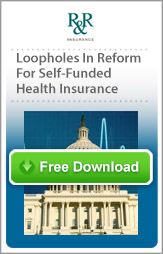Self Funded Health Plan Overview
- Self funding treats predictable claim costs as expenses rather than as insurable risk items.
- In a self funded plan model, we will help employers determine the amount of risk that is appropriate for their company.
- Employers purchase stop-loss insurance to protect against catastrophic claims.
- Risk charges, insurance company reserves, and most premium taxes are avoided.
- Self funded plans are governed by ERISA instead of state insurance law.
- In a self funded plan, the employer can either fund expenses as they arise or deposit expected or maximum costs into an account each month.
- Self funding is not just for large employers.
- Employers using a self funded plan approach hire a Third Party Administrator (TPA) to handle the day to day paperwork and claims processing. Expectations of a Third Party Administrator
Self Funded Versus Fully Insured example
Advantages of Self Funded Health Insurance
In a traditional fully insured health plan, your company pays a premium. The premium rates are fixed for a year, and you pay a monthly premium based on the number of employees enrolled in the plan. Your monthly premium only changes during the year if the number of enrolled employees in the plan changes.
The insurer collects the premiums and pays the health care claims based on the benefits in the policy you purchased. The covered persons are responsible to pay any deductible amounts or co-payments required for covered services under the policy.
The cost of a self funded plan has fixed components similar to an insurance premium, e.g., administration fees, stop-loss premium, and variable costs (the claims expense). Basically the total cost of a self funded plan is the fixed administrative costs plus the claims expense less any stop-loss reimbursements. The administrative fees, stop-loss premiums, and any other set fees charged per employee are referred to as fixed costs and are billed monthly based on plan enrollment just like an insurance premium. The employer sponsoring a self funded plan also pays the claims costs incurred by the covered persons enrolled in the plan, and this cost varies from month to month based on health care use by the covered persons. Stop-loss insurance reimbursements are made if the claims costs exceed the catastrophic claims levels in the policy.
Capping Catastrophic Claim Risks
Even though these plans are called self-funded plans, an employer typically does not assume 100% of the risk for catastrophic claims. Rather, the employer buys a form of insurance known as stop-loss or excess-loss insurance to reimburse the employer for claims that exceed a predetermined level. This coverage is purchased to cover catastrophic claims on one covered person (specific coverage) or to cover claims that significantly exceed the expected level for the group of covered persons (aggregate coverage).
Creating Your Self Funded Plan
The flexibility of self funding helps employers use their health benefit plans the way they were originally intended – to attract and retain the best employees in their industry. R&R Insurance can customize a self funded plan to meet your employees’ needs and to satisfy company objectives.
Self Funded Plans Are Not Just For Large Employers
A common but mistaken impression is that self-funding is only for large employers. In fact, self-funded health plans can be prudently set up by smaller employers as well. When we set up a self-funded plan for a smaller employer, we help them select the appropriate level of stop-loss or excess-loss insurance, which provides reimbursement for large catastrophic claims. Stop-loss insurance enables smaller employers to consider this very economical approach to providing employee health benefits because it protects them from large claims.
Is Self Funding Right For Your Company?
The only way to know if your organization can benefit from self funding is to analyze your existing plan design and recent claims experience. Advantages of Self Funding Health Insurance. R&R Insurance provides this analysis at no cost or obligation. See a Self Funded versus Fully Insured example.
Administration of a Self Funded Health Plan
Employers with self funded health plans hire a Third Party Administrator (TPA) to pay and manage medical claims, procure reinsurance coverage, and to establish a provider network, utilization review, precertification, and large case management. Employee benefit plan administration is complex, it is therefore pertinent to hire a TPA to provide these services. Since there also can be extreme business pressures in the area of claim payment with employees and HIPAA privacy reasons, it is wise to retain a neutral third party administrator to administer your self funded health plans. Also, TPA’s tend to be more aggressive in claims adjudication procedures and standards. It is not advisable to administer the plan in-house with your own employees as this subjects the employer to liability under HIPAA for privacy reasons. See Expectations of Third Party Administrators.



